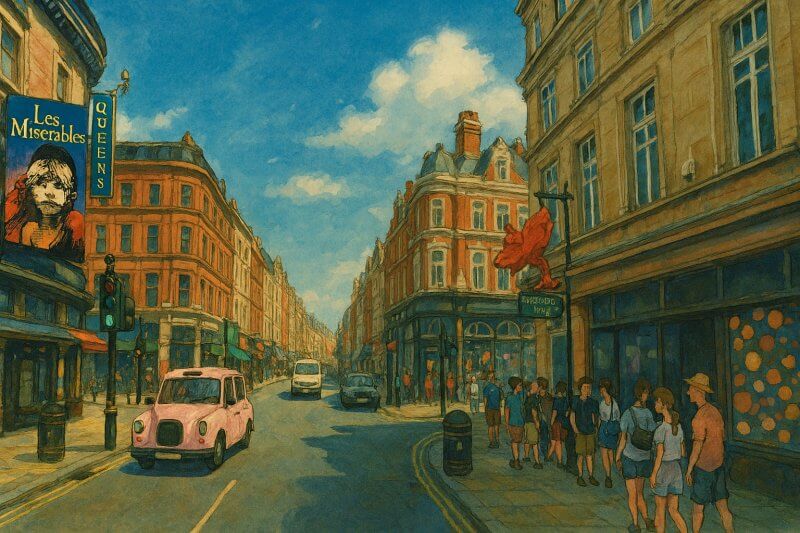
Shaftesbury Avenue: London's Theatreland Boulevard
Introduction
Shaftesbury Avenue is one of the most iconic streets in central London, celebrated for its dazzling theatres, historic architecture, and its central role in the West End's bustling arts scene. Located in the City of Westminster and stretching into the London Borough of Camden, this street is a must-visit for theatre lovers, architecture buffs, and anyone wanting to experience the energy of central London.Where is Shaftesbury Avnue?
Shaftesbury Avenue runs through the heart of London's West End, beginning at Piccadilly Circus and continuing northeast until it meets New Oxford Street near Tottenham Court Road Station. The street acts as a dividing line between Soho to the north and Covent Garden and Chinatown to the south. The street sits primarily within the City of Westminster, although a small stretch falls within the London Borough of Camden, especially towards its eastern end.How long is Shaftesbury Avenue?
Shaftesbury Avenue measures approximately 0.6 miles (1 kilometre) in length, making it a walkable thoroughfare filled with landmarks, theatres, and restaurants packed into a short but culturally rich distance.How long is Shaftesbury Avenue?
Shaftesbury Avenue measures approximately 0.6 miles (1 kilometre) in length, making it a walkable thoroughfare filled with landmarks, theatres, and restaurants packed into a short but culturally rich distance.A brief history of Shaftesbury Avenue
Shaftesbury Avenue was created in the 1880s as part of a major Victorian-era initiative to relieve traffic congestion and improve access to the rapidly developing West End. Construction began in 1886 and was completed by 1887. The street was laid out by the Metropolitan Board of Works and became one of the first modern roadways intended to cut through an older and more cramped medieval street plan. At the time, much of the surrounding area was made up of slums, and the avenue's creation was as much about social reform as it was about improving traffic. The road cut through densely populated housing areas and was intended to clear out poor-quality dwellings, improve sanitation, and open up space for development.Why is it called Shaftesbury Avenue?
Shaftesbury Avenue was named in honour of Anthony Ashley Cooper, 7th Earl of Shaftesbury (1801-1885), a Victorian politician and philanthropist renowned for his work on social reforms. He championed better conditions for the working class, including factory reforms and child labour laws. Naming the avenue after him was a nod to both his influence and the street's purpose as a symbol of urban improvement and progress.Roads that connect to Shaftesbury Avenue
Shaftesbury Avenue intersects or connects with several notable roads, including:- Piccadilly Circus (its starting point)
- Great Windmill Street
- Wardour Street
- Dean Street
- Greek Street
- Charing Cross Road
- Cambridge Circus
- Gower Street (indirectly via New Oxford Street)
- Bloomsbury Street (at its eastern end)
The Character of Shaftesbury Avenue
Shaftesbury Avenue is overwhelmingly commercial and cultural in nature, and it serves as the backbone of London's Theatreland. The street is lined with grand Edwardian and Victorian buildings, many of which house world-famous theatres. While some upper floors may contain office space or residential flats, the street is primarily about entertainment, shopping, dining, and tourism.The vibrant mix of street performers, theatregoers, and visitors from around the globe make this one of London's most animated and cosmopolitan stretches.
Theatres and Notable Buildings
Some of the most celebrated theatres in London can be found on Shaftesbury Avenue, including:- Lyric Theatre - Opened in 1888, currently hosting popular musicals.
- Apollo Theatre - Known for both classic and contemporary productions.
- Gielgud Theatre - Originally called the Hicks Theatre, it was renamed in honour of Sir John Gielgud.
- Sondheim Theatre (formerly the Queen's Theatre) - Home to the long-running Les Misérables.
- Palace Theatre - Just off Shaftesbury Avenue at Cambridge Circus, famous for hosting Harry Potter and the Cursed Child.
- Chinatown Gate, accessible via Gerrard Street.
- Curzon Soho Cinema, a favourite for indie and foreign films.
- A variety of shops, pubs, and international restaurants, reflecting London's multicultural vibrancy.
Nearest London Underground Stations
Shaftesbury Avenue is well-served by multiple Tube stations:- Piccadilly Circus (Bakerloo and Piccadilly lines) - Western end of the street.
- Leicester Square (Northern and Piccadilly lines) - Just a block south.
- Tottenham Court Road (Central, Northern, and Elizabeth lines) - Near the eastern end.
- Covent Garden (Piccadilly line) - A short walk southeast.
- Oxford Circus (Bakerloo, Central, and Victoria lines) - A few minutes northwest of the western end.
Fun Fact
Did you know that Shaftesbury Avenue has appeared in numerous films, television shows, and video games? It's often used as a shorthand for the West End in international media. And, thanks to its strategic location, it's one of the streets featured in the UK version of Monopoly - a true testament to its fame and cultural relevance.In Summary
Shaftesbury Avenue is more than just a road - it's the beating heart of London's theatre district, where art, history, and entertainment converge. Whether you're catching a world-class performance, exploring side streets filled with charm, or just soaking in the city's buzz, Shaftesbury Avenue offers a quintessential London experience.
Painting of Shaftesbury Avenue: London's Theatreland Boulevard